- Morgan/Andrew/Alex Group
https://docs.google.com/document/d/1u6A_d39Xxu8b58TQ9_jFSWN-wpn-_uzO2xVJ4Efdzzs/edit?usp=sharing
Disinformation Issue on Social Media:
Twitter Bot Accounts
Twitter bots are automated social media accounts that are controlled by bot software. They are programmed to perform tasks similar to other twitter users, but their purpose is to tweet and retweet content for specific goals on a large scale.
Source: Norton.com
How to check if an account is a bot account:
- Profile – Check to see if the account has no profile picture, spelling mistakes in their bio, and no followers. If they joined the platform recently this could also be a red flag.
- Posts – Frequent posting (beyond a normal level) may indicated the account could be automated, and is created to promote certain opinions
- Point of view – If the account repeats the same viewpoint or hashtags over and over without any new information they may be programmed to act this way
Source: BBC Website
Example: Coronavirus Fears
-
- “27% increase in ‘bad’ bot traffic for February was due to bots exploiting coronavirus fears, commenting under posts with fake personal Covid-19 stories”
- Source: BBC Website
-
- Since January 2020 researchers analyzed over 200 million tweets discussing coronavirus or COVID-19. Of the top 50 influential retweeters, 82% are bots, and of the top 1,000 retweeters, 62% are bots.
- Source: Carnegie Melon University Study
-
- 2 times as much bot activity as in previous crises
- Source: CNN Business, Kathleen Carley, a computer science professor at Carnegie Mellon
Source: MDPI Bots as Active News Promoters: A Digital Analysis of COVID-19 Tweets
Example of a bot account:
Bots often lack uniqueness and often seem inhuman in the way they interact with other accounts.
- Characteristics of bots
- No or little followers
- Recently joined twitter
- No last names, alphanumeric usernames (ex. Alex3828983982)
- Only have tweeted a few times
- Their posts are centered around spreading alarmist comments
- Mostly follow news sites and government officials
Solution: 3rd party browser extension called “BotSlayer” which is : an extension that helps track and detect potential manipulation of information spreading on Twitter. BotSlayer uses a detection algorithm to identify hashtags, links, accounts, and media that are being amplified in a coordinated fashion by likely bots. Users can view/explore tweets and accounts associated with such amplification on Twitter or search for related content.Source: Rand.org
Benefits of Solution:
- Causes a more streamlined information of facts
- Causes less pandemonium
- Saves everyone time from reading through all of the bot comments in order to get to the real sources
- Slows down the spread of disinformation, and giving people a false idea of what the rest of the world thinks.
- Helps stop bad information from going viral; bot accounts take advantage of social media algorithms to help push misformation.
- Bot Vaccine Appointments (scalper bots)
- There are bots (called Scalper Bots) that are refreshing and taking vaccine appointments, similar to having a code refresh and buy world series tickets, groups of people are essentially taking all the vaccine slots and reselling them to people.
Source: Mercury News
Potential Drawbacks of Solution:
- Potentially discarding real sources of information as bots and filtering out relevant information by misinterpreting posts as bot feeds.
- It would make it more difficult to see the other point of view, given that bots do represent a stance on a topic.
- Stops “helpful bots” from spreading information like the one shown below that is promoting people in the San Diego Area to get vaccinated. Not all bot information is bad, but a large majority of posts on social media are detrimental to spreading information.
- They can remind people that there are vaccination appointments up for grabs in a given region.
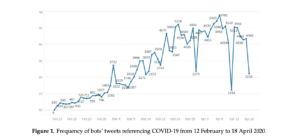
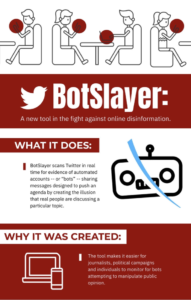
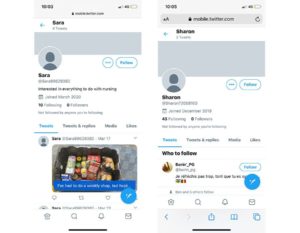
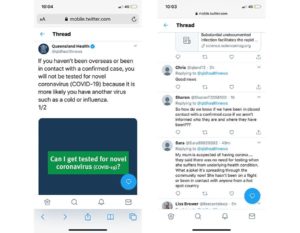
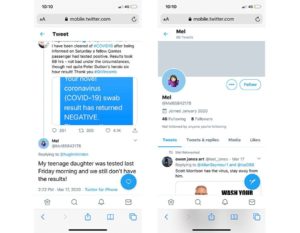
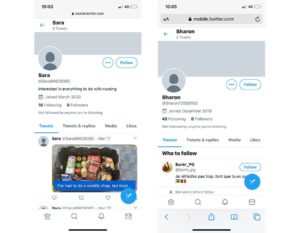
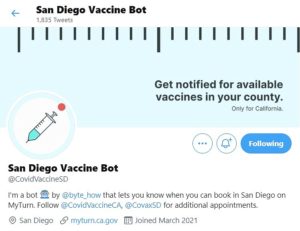
2. Group 2:
Adie, Max, Ryan
Group 3: Marc, Carlli, Lauren
Group 4: Tim, Maclane, Peter
Group 5: Bella, Maddy, Nico
